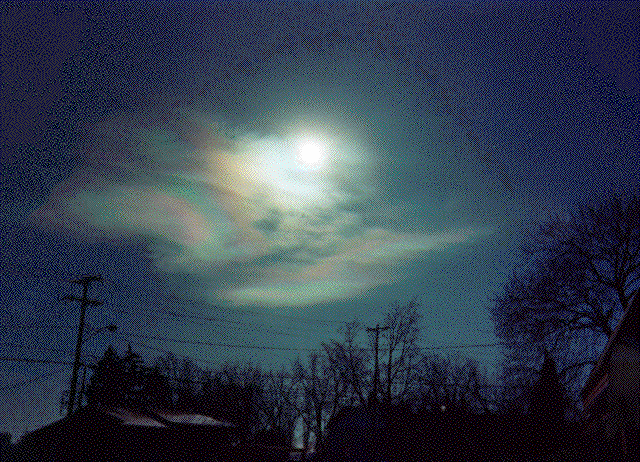
Here is a picture of an iridescent cloud that I took one winter day. Notice the iridescent color bands, especially green and red, that occur at different distances from the sun. These colors form in the region of the cloud where the cloud droplets are all tiny and nearly the same size. Notice the banded structure of the colors. The size of the cloud droplets determines the distance between two rings of the same color.

Photo by Steve Ackerman
To understand this phenomenon let's review the four basic theories of light. Each theory was derived at a different point in time and each has its advantages and disadvantages. None of the theories are completely satisfactory in that they can easily explain all the behaviors of light.
Newton proposed this theory that treats light as being composed of tiny particles. We use this theory to describe reflection. While the theory can explain the primary and secondary rainbows, it cannot explain the iridescent cloud.
Proposed by Huygens, this theory describes light as waves that spread out from the source that generates the light. Each color is a different wavelength. Iridescence is explained by assuming that light is a wave.
Maxwell's theory describes light has having electric and magnetic properties--electromagnetic waves. It is an improvement over the wave theory in that it explains how light is generated. Visible light is only one type of electromagnetic wave. This theory is very math intensive and we won't discuss it in this course.
This theory is more mathematical than Maxwell's equations! It is similar to the corpuscular theory of Newton, except that instead of describing light as particles, light is composed of 'packets of energy' or photons. The energy of the photon determines the color.
To explain the iridescent cloud we use of the wave theory of light. Waves consist of crests and troughs. The distance between two crests (or two troughs) is the wavelength. Before talking about light, lets consider water waves.
Image two water waves having different wavelengths and traveling towards one another. These two waves will interact, and produce a surface with very different characteristics. This interaction of the two waves is called interference.

Constructive interference occurs when the crest of one wave is aligned with the crest of the other and the two waves produce large crests and deep troughs. Constructive interference occurs when the waves are in-phase. Destructive interference occurs when the waves are out-of-phase (troughs align with crests) and the waves tend to cancel one another. In the case of light, constructive interference produces bright bands, and destructive interference dark bands. Interference occurs with all waves. (Sound is a wave. If you are a musician, or not a musician, you may have noticed that when two different notes are played a regular series of pulses is heard. The beats are a result of the interference of the two sound waves.)
An advantage of the wave theory of light is that it explains how light can bend around objects. Have you ever watched ocean or waves strike a pier? Though the waves cannot penetrate the pier, at the end of the pier the waves bend around this obstacle. This bending of waves around objects is know as diffraction. You can experiment with this phenomenon while taking a bath.
Light (being a wave) bends around objects; however, the bending is small and in most situations is difficult to observe. Diffraction or bending is a function of the wavelength (color); Longer wavelengths are diffracted more than short wavelengths. Red light is diffracted more than blue light.
Diffraction of light around a small object results in bright and dark bands that result from the interference of the light waves striking different sides of the object. Rather than go through a mathematical explanation of diffraction, here are some examples:
One more rule; the diffraction pattern of a group of particles of the same size is the same as the diffraction pattern produced by just one of them--but much brighter.
So what does all this have to do with iridescent cloud? To summarize--light bends around objects (diffraction), how much it bends depends on the wavelength, white light is composed of all colors and each color has a different wavelength and therefore is diffracted by a different amount. When the light from the sun interacts with cloud droplets diffraction occurs--the light bends around the edge of the cloud droplet. Different colors are diffracted by different amounts and are therefore in-phase (and out-of-phase) at different distances from the sun. The color bands result as different colors are removed from the sun's light due to destructive interference, while other colors are enforced due to constructive interference.
The iridescent pattern occurs near the edge of the cloud because this is where the cloud is thin. When the cloud gets thick, multiple scattering --a process that destroys colors--dominates.
Coronas around the sun or moon
(The iridescent part of the cloud is actually part of a very large corona around the sun.)
The iridescent colors of an oil slick
Supernumerary rainbows